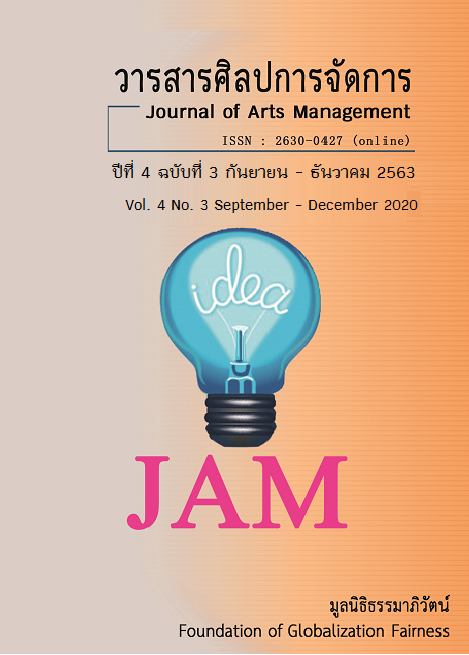Organization Culture and Happy Workplace of Teachers in School under the Secondary Educational Service Area Office 9
Main Article Content
Abstract
The research purposes were to determine 1) the organizational culture of school under the Secondary Educational Service Area Office 9 2) The happy workplace of the teacher in school under the Secondary Educational Service Area Office 3) the relationship between the organizational culture and the happy workplace of teacher’s in school under the Secondary Educational Service Area Office 9. The samples were 52 schools under the secondary educational service area office 9. The respondents in each school were a director, a deputy director or assistant director, and teachers with a total of 312. The research instrument was a questionnaire concerning the organizational culture and the happy workplace of teachers. The statistics were used to analyze data included frequency, percentage, arithmetic mean, standard deviation and Pearson’s product-moment correlation coefficient. The results of this research were as follows:
- The organizational culture of school under the Secondary Educational Service Area Office 9, in overall and individual, were found at a high level; ranking from descending order: Acceptance, Generosity, Honesty, Workforce Diversity, Organization Goals, Devolution, Organization Unity, Trust, Quality, and Decision making.
2.The happy workplace of teacher in school under the Secondary Educational Service Area Office collectively and individually, was found at a high level; ranking from the highest mean to the lowest mean : Happy soul , Happy Family, Happy brain , Happy heart , Happy money , Happy society, Happy body , and Happy relax .
- The relationship between organizational culture and the happy workplace of teacher in school under the Secondary Educational Service Area Office 9 was found at .01 level of a statistical significance.
Article Details
Views and opinions appearing in articles in the Journal of Arts of Management It is the responsibility of the author of the article. and does not constitute the view and responsibility of the editorial team I agree that the article is copyright of the Arts and Management Journal.
References
กชนิกา พลจันทึก. (2556). ความสัมพันธ์ระหว่างวัฒนธรรมองค์กรกับการจัดการความรู้ของสถานศึกษา สังกัดสำนักงานเขตพื้นที่การศึกษามัธยมศึกษา เขต 4 จังหวัดปทุมธานี. (วิทยานิพนธ์ศึกษาศาสตร์มหาบัณฑิต สาขาวิชาเทคโนโลยีการบริหารการศึกษา). มหาวิทยาลัยเทคโนโลยีราชมงคลธัญบุรี.
กัญญ์ภัคญา ภัทรไชยอนันท์. (2557). วัฒนธรรมองค์กรกับองค์กรแห่งการเรียนรู้ของคณะศึกษาศาสตร์ มหาวิทยาลัยศิลปากร. (วิทยานิพนธ์ปริญญามหาบัณฑิต สาขาการบริหารการศึกษา). มหาวิทยาลัยศิลปากร.
กาญจนา เกสร. (2555). ความสัมพันธ์ระหว่างวัฒนธรรมองค์การกับประสิทธิผลของโรงเรียนสังกัดสำนักงานเขตพื้นที่การศึกษาประถมศึกษาปทุมธานี เขต 1. (วิทยานิพนธ์ปริญญามหาบัณฑิต สาขาเทคโนโลยีการบริหารการศึกษา). มหาวิทยาลัยเทคโนโลยีราชมงคลธัญบุรี.
สำนักงานกองทุนสนับสนุนการสร้างเสริมสุขภาพ (สสส.). (2551). HR & HAPPY WORKPLACE. กรุงเทพฯ: แผนงานสุขภาวะองค์กรภาคเอกชน.
สำนักงานเขตพื้นที่การศึกษามัธยมศึกษา เขต 9. (2562). รายงานผลการดำเนินงานประจำปีงบประมาณ พ.ศ. 2561. สืบค้นเมื่อ 9 มกราคม 2562. จาก http://www.mathayom9.go.th/webspm9 /data/plan61.pdf
สำนักงานเขตพื้นที่การศึกษามัธยมศึกษา เขต 9. (2563). แผนปฏิบัติการโครงการเสริมสร้างคุณธรรม จริยธรรม และธรรมาภิบาลในสถานศึกษาสำนักงานเขตพื้นที่การศึกษามัธยมศึกษา เขต 9 ประจำปีงบประมาณ 2563. สืบค้นเมื่อ 14 มกราคม 2563. จาก http://www.mathayom9.go.th /webspm9/data/planp63.pdf.
สำนักงานปลัดกระทรวงศึกษาธิการ. (2559). แผนพัฒนาการศึกษาของกระทรวงศึกษาธิการ ฉบับที่ 12. สืบค้นเมื่อ 1 ตุลาคม 2559. จาก http://www.mua.go.th/users/bpp/main/download/plan/Education Plan12.pdf
อนุพงศ์ รอดบุญปาน. (2561). องค์กรแห่งความสุขของโรงเรียนอนุบาลกุยบุรี (วัดวังยาว). (วิทยานิพนธ์ปริญญามหาบัณฑิต สาขาการบริหารการศึกษา). มหาวิทยาลัยศิลปากร.
Likert, R. (1967). “The Method of Constructing and Attitude Scale”. In Reading in Fishbeic, M (Ed.), Attitude Theory and Measurement (pp. 90-95). New York: Wiley & Son.
Patterson, J. L. et al. (1986). Guiding Beliefs of Our School District. Productive School Systems for a Nonrational World. Ubrld Arlington, Va: Association for Supervision and Curriculum Development.


